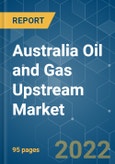The Australian oil and gas upstream market is expected to record a CAGR of more than 2% during the forecast period (2022-2027). The COVID-19 outbreak affected the market negatively, causing a global decline in the demand for crude oil and a crashing of oil prices worldwide. These factors led to a decline in upstream activities due to economic unfeasibility. The market is expected to recover once the restrictions imposed to contain the pandemic are lifted. Factors such as a large proven hydrocarbon resource base and stability of government regulations are likely to drive the market during the forecast period. However, the volatility of crude oil prices and higher production costs from unconventional resources are likely to restrain the market’s growth during the forecast period.
The Australian oil and gas upstream market is moderately consolidated. Some of the major players in the market include Shell PLC, Chevron Corporation, BP PLC, ExxonMobil Corporation, and Woodside Petroleum Ltd.
This product will be delivered within 2 business days.
Key Highlights
- The offshore segment is expected to dominate the market during the forecast period.
- Australia has about 2.4 thousand million barrels of total proven oil reserves, which can be exploited in the future for commercial production. This factor is likely to present opportunities for the players in the Australian oil and gas upstream market.
- The country's shift toward renewable energy sources is likely to restrain the market during the forecast period.
Key Market Trends
Offshore Segment to Dominate the Market
- Australia derives most of its oil and gas production from offshore fields. The offshore reserves contribute a significant share of oil and gas resources to the Australian economy, accounting for over 85% of petroleum production in 2020.
- Petroleum production in the country has been declining over the years, mainly because of the country’s shifting focus toward natural gas. As of 2020, Australia was the second-largest exporter of petroleum after Qatar.
- With healthy support from the government, offshore exploration and production activities in Australia are expected to witness a significant increase during the forecast period. In August 2021, Australia’s parliament passed the Offshore Petroleum and Greenhouse Gas Storage Amendment Bill 2021 to strengthen the country’s offshore oil and gas regulatory framework.
- In March 2021, Beach Energy made a gas discovery at the Artisan 1 exploration well, located about 30 km offshore Victorian Otway Basin, Australia. The well encountered a gross gas column of 69.5 m in the Upper Waarre Formation with a net gas pay of 62.9 m.
- In July 2021, Western Gas announced its plans to start drilling work at the Sasanof-1 exploration well offshore Western Australia in early 2022. The Sasanof Prospect estimated resources of 24 trillion cubic feet (Tcf) of gas and 1.1 billion bbls of condensate, which may bolster the country's production capabilities.
- Due to the factors mentioned above, the offshore segment is expected to dominate the Australian oil and gas upstream market during the forecast period.
Shift Toward Renewable Energy Sources Likely to Restrain the Market
- Over the past decade, renewable energy usage in Australia increased much faster than non-renewable fossil fuel sources. The most widely deployed renewable energy source in Australia are solar and wind power sources, contributing to more than 90% of the renewable energy in 2020.
- In 2020, the renewable energy source witnessed an average growth of 21%, with 49.9 Terawatt-hours (TWh) of total power generation compared to 41.2 TWh in 2019. Solar generated about 23.84 TWh, followed by wind generating 22.6 TWh and 3.41 TWh by other renewable sources such as hydropower and bioenergy.
- In 2020, Australia’s total installed solar capacity was 17,625 MW compared to 13,564 MW in 2019, witnessing a significant growth rate of 30%. The total installed wind capacity in 2020 was 9,457 MW compared to 7,133 MW in 2019. The growing concerns about the environmental impacts of the usage of fossil fuels have driven the rapid growth of the renewable energy market, which may continue during the forecast period.
- Additionally, renewable energy projects benefit from government schemes and incentives such as feed-in-tariff (FiT) and net-metering schemes. Due to these factors, despite the relatively higher cost, renewable energy prices are competitive with the price of electricity generated from natural gas.
- In March 2022, Acciona secured environmental approval for its 923 MW Maclntyre wind project in Queensland, Australia. The construction is expected to begin in the second quarter of 2022 and finish by 2024.
- Thus, the increasing renewable energy adoption in Australia is likely to restrain the Australian oil and gas upstream market during the forecast period.
Competitive Landscape
The Australian oil and gas upstream market is moderately consolidated. Some of the major players in the market include Shell PLC, Chevron Corporation, BP PLC, ExxonMobil Corporation, and Woodside Petroleum Ltd.
Additional Benefits:
- The market estimate (ME) sheet in Excel format
- 3 months of analyst support
This product will be delivered within 2 business days.
Table of Contents
1 INTRODUCTION
4 MARKET DYNAMICS
5 MARKET SEGMENTATION - BY LOCATION OF DEPLOYMENT
6 COMPETITIVE LANDSCAPE
Companies Mentioned (Partial List)
A selection of companies mentioned in this report includes, but is not limited to:
- Shell PLC
- Total Energies SE
- Chevron Corporation
- ExxonMobil Corporation
- BP PLC
- Woodside Petroleum Limited
- BHP Group PLC
- Origin Energy Limited
- Santos Limited
- Caltex Australia Limited
Methodology

LOADING...








